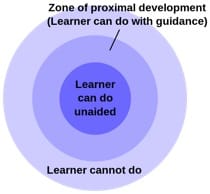Pre-Assessment: A Key to the ZPD
CompetencyWorks Blog
 The Zone of Proximal Development is the sweet spot of education; this is where meaningful learning happens. We all read about Vygotsky and Social Development Theory at some point in our teacher education.
The Zone of Proximal Development is the sweet spot of education; this is where meaningful learning happens. We all read about Vygotsky and Social Development Theory at some point in our teacher education.
The ZPD is at the core of performance-based learning, individualized learning, and customized learning. So, how many of us still keep the basic idea of the Zone of Proximal Development at the forefront of our thinking and planning for teaching and learning? Well, when’s the last time you gave a pre-assessment and used it to plan instruction?
Vygotsky himself defines the ZPD as “the distance between the actual development level as determined by independent problem solving and the level of potential development as determined through problem solving under adult guidance or in collaboration with more capable peers” (Vygotsky, 1978). In other words, a student is in the ZPD when they still need support from a teacher or a peer in order to do or understand something new. Once they no longer need teacher or peer support, they are out of the ZPD for that particular skill or understanding. This video does a nice job of explaining it. There are some things to remember about the ZPD:
- The ZPD varies by individual for any given skill or understanding
- The ZPD varies by skill or understanding for any given individual
- The ZPD changes for any given individual as they gain skills and understandings
Pre-assessment is an important key to targeting the ZPD for students in your classroom. If pre-assessment is left out of a unit or project plan there is a good chance you will be missing the ZPD for a significant portion of students. Instruction will either be below the ZPD not supporting the stretch needed to master new skills and understandings, or above the ZPD requiring a stretch beyond what can be supported in order to master new skills and understandings. Either way, students easily become disengaged because the instruction is not meaningful to them as a learner. When used in combination with clear learning targets and learning progressions, pre-assessments allow teachers to isolate which areas of learning in relation to a particular skill or understanding needs support. Even if you are not actively using targets and learning progressions yet, pre-assessment still helps you plan meaningful instruction for all the learners in your classes. Here are three ways to pre-assess your students:
1. Give The Test First. This is actually one of the best ways to make learning clear to students, and to make it clear to you what they do and do not know. Use the results from the test to re-plan instruction, make small groups, and determine the need for advanced-level work. Go a step further and have the students do a quick error analysis to have them figure out what it is they need to learn.
2. Anticipation Guide. This tool is great for unearthing confusion related to conceptual understandings. Many times this strategy is used before reading, but it can be used before any learning experience. Students are asked to agree or disagree with a series of statements related to a topic. Anticipation guides are typically structured as a paper-pencil activity for individual students, but it can also be structured as a group activity utilizing physical movement. Figuring out a way to capture the class responses to the questions if the activity is not paper-based is important if you want to compare start-of-unit thinking with end-of-unit thinking.
3. KWL. Students make a three-column chart listing what they already know about a topic and what they want to know, or wonder, about a topic at the start of the unit. As the unit progresses, or at the end, the students add items to a list of what they learned in the final column.
There are many more ways to pre-asses, and any of these can be made digital using variety of tools and programs. Below are some more links and resources to use for exploring pre-assessment.
Websites:
STEMResources.com
DareToDifferentiate
Principal Kendrick
Books and Articles:
Seven Practices for Effective Learning
What Teachers Really Need to Know About Formative Assessment, Laura Greenstein
Exploring Differentiated Instruction, Cindy A. Strickland
Formative Assessment Strategies for Every Classroom: An ASCD Action Too
Embedded Formative Assessment, Dylan William
Courtney Belolan works at RSU 2 in Maine where she supports K-12 teachers with performance-based, individualized learning. Courtney works closely with teams and teachers as a coach, and with the school and district leadership teams as an instructional strategist. Courtney has worked as a 6-12 literacy and instructional coach, a middle level ELA teacher, an environmental educator, and a digital literacy coach. Her core beliefs include the idea that the best education is one centered on student passions and rooted in interdisciplinary applications, and that enjoying learning is just as important as the learning itself.
